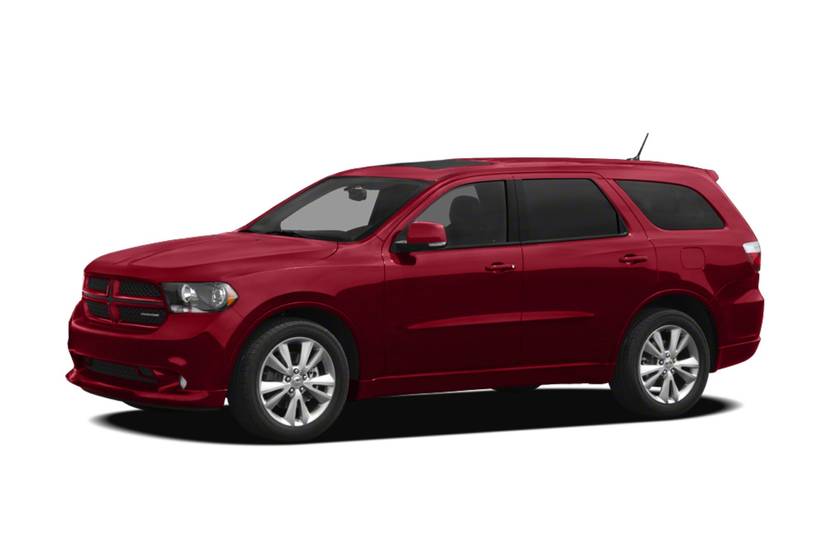
The 2012 Dodge Durango SUV remains a solid choice for families that need three rows of seats and good towing power, but the V-8 engine isn’t as stout as its specs suggest, and the R/T’s sport suspension compromises ride comfort.
We reviewed the redesigned 2011 Dodge Durango last year, and the seven-seat SUV impressed us with its poised ride, refined interior and good V-6 power. In revisiting this full-size SUV for the 2012 model year, a familiar axiom surfaced: Bigger isn’t always better.
Our all-wheel-drive Durango R/T with the bigger of the two available engines, a 5.7-liter V-8, had an as-tested price of $39,240. To compare the Durango’s specs with the Chevrolet Traverse, Ford Explorer and Nissan Pathfinder, click here.
Modest V-8 Power
In everyday driving, the performance difference between the Durango’s standard 3.6-liter V-6 and available 5.7-liter V-8 isn’t that significant. In fact, it’s so inconsequential that the thirstier, more expensive V-8 is unnecessary unless you need its extra towing capacity (up to 7,400 pounds; 1,200 pounds more than the V-6 can tow).
The V-8 delivers adequate acceleration in the city and at highway speeds, but it doesn’t produce the kind of thrust you’d expect from an engine with 360 horsepower and 390 pounds-feet of torque, which makes you wonder, “Is that all you’ve got?” To be sure, the engine is lugging around a lot of weight — the all-wheel-drive R/T’s curb weight is 5,331 pounds — but the V-6 is nearly as burdened. It’s a testament to the strides Chrysler has made with its 3.6-liter V-6 engine.
The V-8 is matched to a six-speed automatic transmission that shifts smoothly and makes swift kickdowns on the highway — though it takes a deep prod of the gas pedal to evoke the downshift, which can leave you waiting a bit when you want more power.
Gas mileage trails the V-6 by a significant amount. The all-wheel-drive Durango V-8 gets an EPA-estimated 13/20 mpg city/highway, compared with the V-6’s 16/23 mpg. To save gas, the V-8 incorporates cylinder-deactivation technology, which automatically — and unobtrusively — shuts down half of the engine’s cylinders under light loads.
R/T Compromises Ride Comfort
Some of my lasting impressions from our previous time in the Durango were of its exceptional ride comfort and highway poise — all the more noteworthy considering its SUV roots. The highway poise remains, but ride comfort suffers in the R/T, which is fitted with a sport suspension. It also has a performance steering setup, which bothered one editor with its unassisted feel, especially at low speeds.
The R/T completely lacks the comfortable ride of the V-6 Crew trim level we tested previously, replacing it with firm suspension tuning that transmits the shock of bumps and holes in the road in a way that recalls a sporty car. There’s just one problem: The Durango is anything but sporty, what with its 16-foot-plus overall length and considerable heft.
Interior Quality, Roominess Remain Strengths
Like other Chrysler products, the Durango benefits from the automaker’s newfound commitment to interior quality, which can be seen elsewhere in models like the Jeep Grand Cherokee and Chrysler 300. It’s far better than the prior-generation Durango’s cabin — which was finished in crude, gray plastic — and makes the interior feel more welcoming and luxurious.
It’s also comfortable. The front bucket seats have long cushions and wide backrests that form to your back. The R/T’s seats are covered in perforated suede and vinyl, and they complement the cabin’s premium appearance.
There’s adequate second-row legroom for taller passengers (I’m 6-foot-1), but my shins touched a hard plastic panel on the back of the driver’s seat. The second-row backrest reclines, letting you customize the seating position.
The third row accommodates adults, but smaller rear-quarter windows can make it feel a little claustrophobic. The Ford Expedition’s third row is a little roomier, but that SUV is significantly larger overall.
Safety
The Insurance Institute for Highway Safety recognized the Dodge Durango as a 2012 Top Safety Pick. Honorees must achieve Good scores in IIHS’ frontal-offset and side-impact crash tests, as well as its roof-strength test and rear-impact test, the latter of which evaluates how well the front seats protect against whiplash injuries.
As is required on all 2012 and newer cars, antilock brakes and an electronic stability system are standard. Additional standard safety features include side-impact airbags for the front seats and side curtain airbags for all three rows.
Optional safety features include a blind spot warning system, rear cross-path detection and a collision warning system. There are optional backup aids — rear parking sensors and a backup camera — that deserve to be standard. I don’t usually feel a need for these features, but I did in the Durango. Its considerable bulk, combined with marginal rear visibility, make reversing a challenge, and I longed for an electronic backup assistant.
For a list of safety features, check out the Features & Specs page, or take a look at our Car Seat Check to see how well child-safety seats fit in the Durango.
Durango in the Market
Gas prices were high when we reviewed the Durango more than a year ago, and they’re higher still today; the nationwide average for a gallon of regular is $3.85, according to AAA. That hasn’t put a damper on Durango sales — at least not yet; they’re up 33 percent through March 2012. A stronger economy and more confident consumers are no doubt driving some of the gains, but it’s further evidence that Americans like their vehicles big — and are willing to pay for the privilege at the pump.
If the thought of $100 fill-ups doesn’t make you queasy, the Durango is a good choice in this segment. However, take a pass on the R/T’s sport suspension and the V-8 to get a more comfortable, fuel-efficient version. You’ll also save some money on the purchase price, which you can set aside for those fill-ups.
| Send Mike an email |



























































